Thessaloniki is the second largest city in Greece. It is a place filled with culture, rich history, and colorful markets. Formerly known as Salonika, Thessaloniki has played an important role in urban trade due to its location in the Roman era. Once it was conquered by the Romans, they turned Thessaloniki into one of their four districts and also built a harbor to help the city flourish.
With time Thessaloniki started gaining more and more population and after a while, it was home to many Christians and Jewish as well. The city performed really well, and during the Byzantine era, it became the capital of the Byzantine Empire as well. Thessaloniki also became the main hub for trade in all of Greece.
Throughout history, many empires ruled Thessaloniki and left once they were defeated. This change of civilizations helped Thessaloniki develop over time, and it became a multicultural state in all of Greece. The emperors of the time built some magnificent attractions around Thessaloniki to mark their territory and declare the city as their own. But, in 1997, Thessaloniki became a European city of Culture and has been an independent state ever since.
Ever since its independence, Thessaloniki has been a great attraction for visitors from all over the world. They visit the Greek city to explore its multicultural heritage, learn more about its history, and visit the beautiful monument which is the main attraction for the tourists.
Other than being a major source of historic information, Thessaloniki is also a fun place when it comes to vacationing. You get to explore a variety of restaurants, enjoy the beaches, and live your days in Greek style. So, if you are visiting Thessaloniki and you are a history geek, then you would want to have a prepped list of places that you would like to visit. How about we provide you with our list and you can check if you have missed any spots?
Find the Top Historic Sites and Attractions in Thessaloniki listed below:
- White Tower
- Arch of Galerius and Rotunda
- Roman Forum
- Byzantine Walls and Trigonion Tower
- Castle of Thessaloniki or Heptapyrgion
- Ataturk’s House
- Ladadika District
- Church of Agia Sofia
- Agios Dimitrios Church
- Roman Market
- Church of Agios Nikolas Orfanos
- Bey Hamam
- Church of Panagia Halkeon
- Park of Dinosaurs
1. White Tower
The White Tower is located in the heart of Thessaloniki, on Nikki Street by the waterfront boulevard. This tower was built back in the 1500s for protection purposes. So, a few soldiers can be placed on the top terrace and keep an eye out in case the enemy decides to attack from the sea. The tower has six floors, which are all connected by stairs, and there is a terrace on the top which gives you a complete view of the whole city. Over history the tower has been used for multiple purposes, the French used it as a watch tower, Ottomans used it as a fort and a prison. Also, it was not white from the beginning, at first it had a rock brick color, then later on during Sultan Mahmud II’s reign, it was named the Blood Tower or the Red Tower, as he massacred all the prisoners who were being held in the tower.
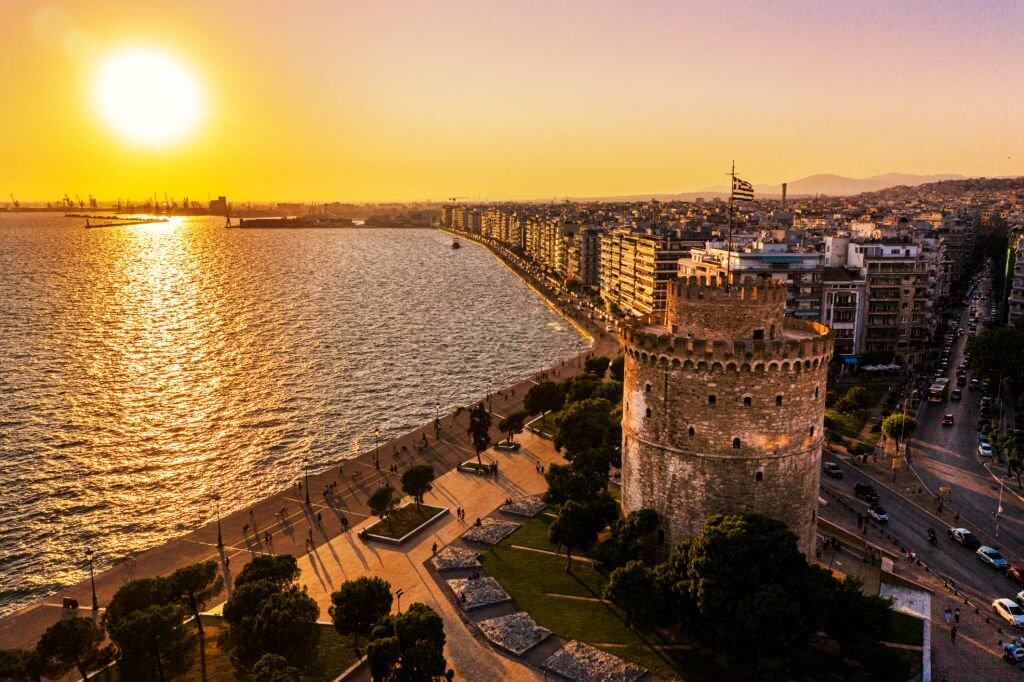
But after getting independence from the Turks, the tower was whitewashed and named the White Tower. Ever since then, it has been a symbol of Thessaloniki. People from all over the world visit the White Tower to learn about its great history. The White Tower is also home to the Byzantine Museum which has a great collection of old relics, monuments, sculptures, Byzantine coins, and more. The tower is open for locals and tourists from 8:00 am to 3:00 pm all week, and there is a small entrance fee of €3 for young people, €2 for senior citizens and free entrance for students who would like to visit the museum for research purposes.
2. Arch of Galerius and Rotunda
Dating back to 298 AD, the Arch of Galerius is one of the most common meeting points in all of Thessaloniki. Built in the middle of the city, a few minutes away from Navarinou Square, the arch of Galerius was built to honor the heroic victory of Galerius against the Persians. The arch used to be a part of Galerius’ palace which he built to hold his courts and to welcome his guests, but due to the massive earthquakes over the course of time, the palace got destroyed and all that was left of it was this beautifully crafted arch. The arch is referred to as the Kamara these days, and if you visit Thessaloniki, you will find many locals talking about meeting at Kamara as it is a common meeting place now. There is no visiting fee of any sort. It is a public property and you can stay here and observe it for as long as you like.
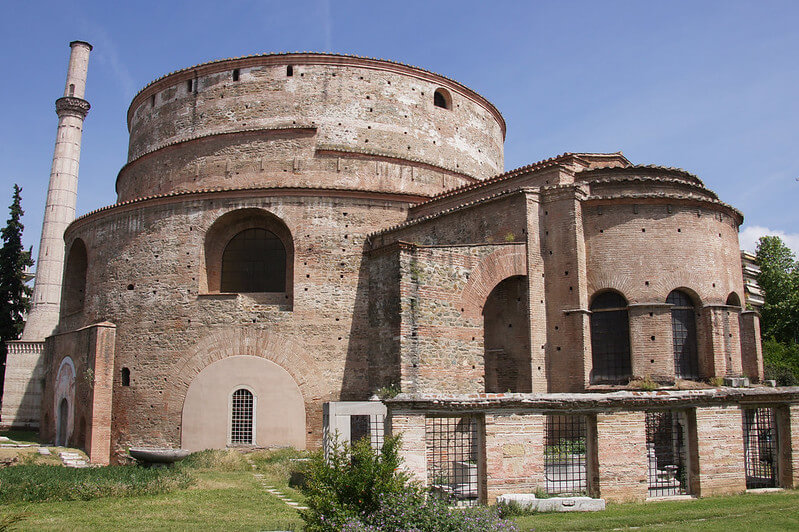
The Rotunda of Galerius, on the other hand, is said to be the oldest monument in all of Thessaloniki. Dating back to the 4th century, this huge round building is located on the northern side of the Arch of Galerius. The Rotunda has served many purposes over the course of time, at first it was used as a tomb house to store multiple tombs, later on, it was turned into a church, and then a mosque. The interior of the Rotunda is designed with an early Christian mosaic, and it is the only original minaret in all of Thessaloniki that has not been damaged over time. During the 4th century, many great emperors were buried here, but once Thessaloniki became the capital of Wes, the Rotunda was converted from being a tomb to a church. It stayed like that for a while until 1591, when the Ottomans and Turks came and converted it into a mosque. These days, however, Rotunda serves as this old archeological building, where people from all over the world visit to experience the greatness of the historic emperors. The Rotunda is open to the public from 8:30 am to 3:30 pm all week, and you have to pay a small entrance fee of €1 to the management.
3. Roman Forum
The Roman Forum is one of the many remarkable monuments that the city of Thessaloniki holds. Located between Dimitriou Street and Egnatia Street, the ruins were built near the end of the 2nd century, the Roman Forum of Thessaloniki was a market square during that time. It used to be filled with people making their daily purchases. The structure of the forum was pretty simple, there were shops, storage rooms, bath areas, temples, etc. with an upper tier, square below, and paved rimmed pillars. The forum was one of the main attractions up till the 5th century, but then the Christians came and made a few changes to the structure, however, it was still a major section until a massive earthquake hit Thessaloniki, and the once-populated town square was abandoned for centuries.
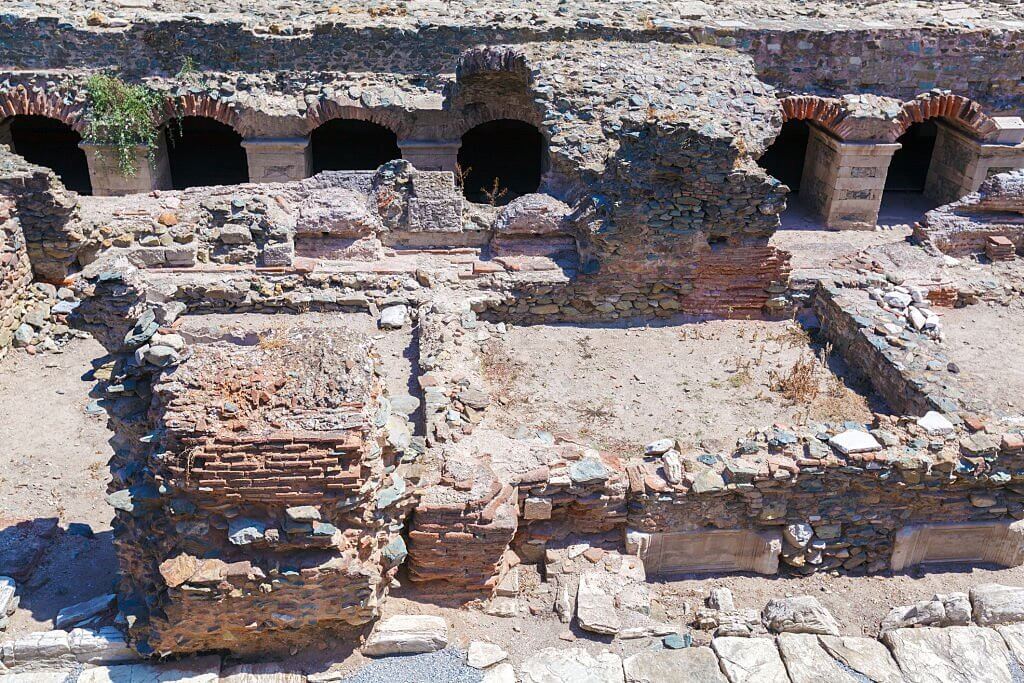
It was not until the 1960s that the ruins were discovered during the construction of the courthouse. As this location was an archeological site, the constructors decided to halt the construction of new buildings and decided to explore the land and learn more about it. The mining process went on from the 1960s to the early 2000s. After that, the site went down through a major restoration process until it was open to the public in 2010. Today, the ancient ruins are used for multiple purposes, such as tourist spots, to organize concerts and performances during peak season. People from all over the world visit this ancient ruin to experience the great Greek architecture. The tall walls with ancient craftsmanship, the construction of shops, and other storage rooms still fascinate the visitors. The Forum is open for public visits from 8:00 am to 3:00 pm every day, and there is no entrance fee to visit the great archeological site.
4. Byzantine Walls and Trigonion Tower
The Byzantine Walls of Thessaloniki are a number of defenses that were built around Thessaloniki, during the Byzantine Empire. These walls were built in different stages, starting from the late 3rd century, and then the emperors kept on making changes to the walls until the early 15th century. The earliest walls were built during the Roman Emperor Galerius’s reign, in the late 3rd century. At first, it was just a single wall and a ditch that used to surround the city. But, in the 5th century, the walls were damaged by the Goths. So, to make it stronger, in the 6th century, the Byzantine emperor ordered the rebuilding of the wall. This time with double walls, battlements, and towers. The walls kept on going under changes over time, for example during the 10th century, thy Byzantine walls were expanded. During the 14th century, the walls were again used for protection, and soldiers were placed in the tower for the third line of defense. By the 19th century, the walls began to be demolished and today only 4km of the walls remain.
These walls are located within a short walking distance from the Arch of Galerius and Rotunda and are an open space for the public to visit, roam around, and explore. Even today, the walls contain cryptic text from the 3rd century, and you can visit here anywhere between 8:00 am to 10:00 pm. Built inside the Byzantine Walls, is a tower called the Trigonion Tower. It was built back in the 15t century to protect the city and act as a siege to hold off forces during an invasion. The tower was named the Trigonion Tower because of its triangular shape, which was not so common during the Byzantine era. People also used to call it the Tower of Winds due to the strong wind pressure on top of the tower. The tower was used by many civilizations over time until it was damaged during the 1978’s earthquake. It was later restored during the early 1990s. Now, this magnificent tower holds a beautiful museum which is open for people who would like to learn about the history of Thessaloniki and its defenses. The museum’s collection includes a number of different weapons from the Byzantine era. You can also climb to the top of the tower and enjoy the stunning view from the top. The museum is open at 8:00 am and closes at 5:00 pm for the public, and entry is free.
5. Visit the Museums of Thessaloniki
Thessaloniki has been blessed with a mixed culture. Since the beginning, the city has been ruled by many different emperors, such as the Turks, Romans, Ottomans, and more. This has left Thessaloniki with a great collection of history and old artifacts which have been stored in a number of museums around the city. These museums are one of the many things that attract people from all over the world to visit this beautiful Greek city. To learn about the history and story behind every artifact. So, when you are in Thessaloniki, and on a hunch to explore the history of the city, there is no chance you would want to miss visiting these museums. There are many museums around Thessaloniki but some of them hold a great place due to the history they hold such as: The Archeological Museum of Thessaloniki is located in a huge house on Manoli Andronikou 6, which was designed by Patroklos Karantinos. The museum itself is a beautifully designed building and shows off the greatness of Greek architecture. The museum first started as a single room in 1962 but was expanded in 1980 to display new artifacts. It went under a number of renovations until 2004 when it was completed and opened again for the public. This museum is the only place in all of Thessaloniki where you can learn everything there is to learn about Macedonia.
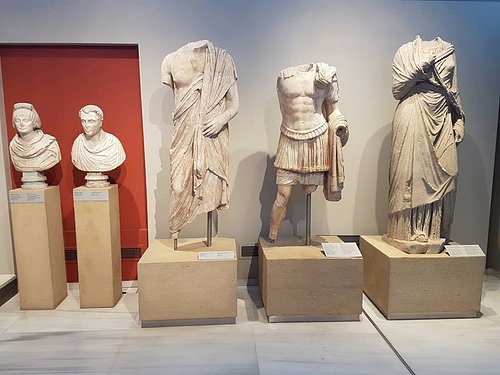
It is the house of prehistoric sculptures, monuments, and warrior armor from the Macedonian, Byzantine, and Roman eras. The museum opens at 8:30 am and closes at 8:00 pm, and all it will cost is €4 only. The collection at the Museum of Byzantine Culture dates to the 2nd and 20th centuries. The idea to open a Byzantine Museum was first introduced in the 1970s with the aim to study and preserve the Byzantine history of Thessaloniki. After being considered and planned for many years, the museum was finally built and opened to the public in 1994. The museum has a total of eleven galleries, where each gallery holds artifacts and different monuments from different eras. You will find objects from the Early Christian Church, Macedonian, and Komnenian Dynasties, and more. The museum opens from 8:30 am to 3:30 pm for the public, and there is an entrance fee of €4. So, if you plan on visiting the museums in Thessaloniki, you must not miss the Museum of Byzantine Culture.
6. Castle of Thessaloniki or Heptapyrgion
Located on a hill in Ano Poli, the Castle of Thessaloniki is known for many things and one of them is the beautiful view of the port, the city, and the Aegean Sea from the castle. Also known as Heptapyrgion, the castle was discovered in 316 BC, by Cassander. The craftsmanship and the construction of the walls have given the idea that the castle is somewhere from the 4th century. During the Byzantine era, many buildings in the town were reconstructed. The name Heptapygrion, is still a mystery, as in old Greek it means seven towers, however, the castle has ten towers in total.
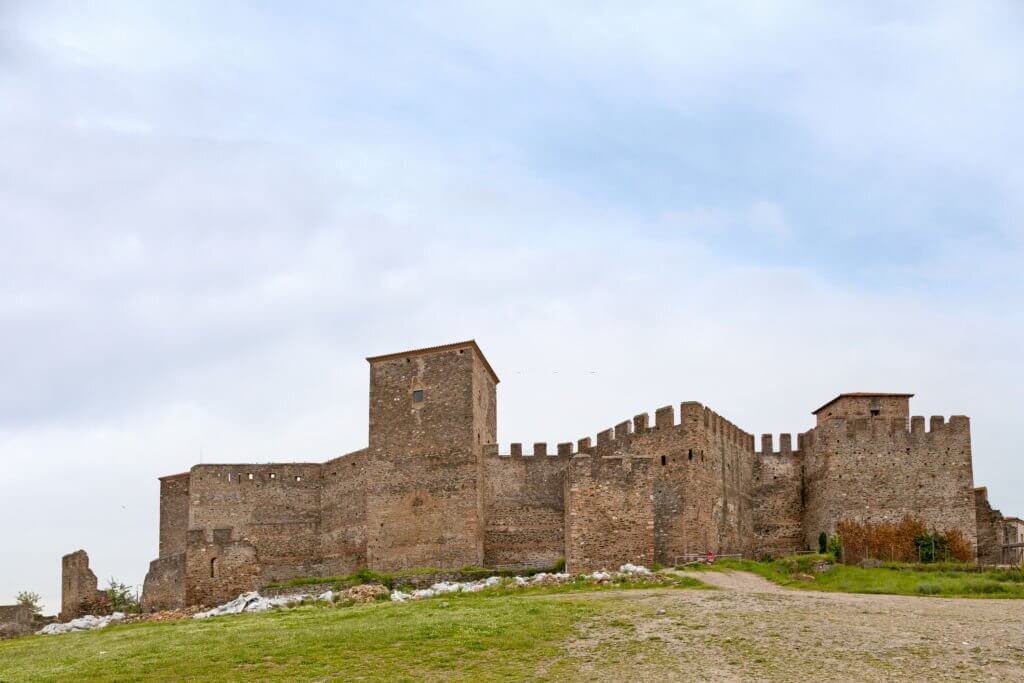
The castle has been used by many emperors of time. From the Byzantine emperor to the Ottomans, and then the Garrison commander sat and ruled Thessaloniki. But in 1989, the castle was turned from being a fortress to a prison and was used to severely torture prisoners. But after the earthquake, the castle was abandoned and destroyed. Today, the Castle of Thessaloniki is under construction, but it is still open for visitors from 10:00 am to 4:30 pm with an entrance fee of €6 only.
7. Ataturk’s House
The Ataturk’s House or also known as the Ataturk Museum is the place where the great Turkish warrior Mustafa Kemal Ataturk was born. Ataturk helped Thessaloniki during the First World War, which was why when the house came under Greek control after the war, the government decided to honor Ataturk and turned the house into a monumental site for the public. However, the house was badly damaged during the Second World War, so it was reconstructed and reopened in the 1950s.
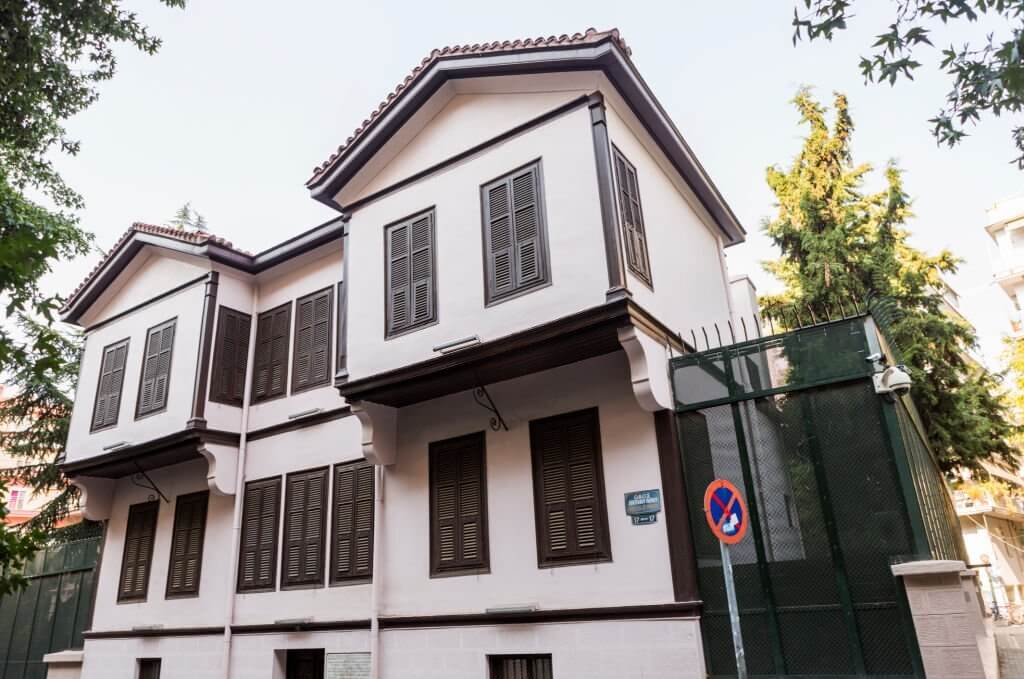
The museum stores some of Ataturk’s personal belongings, which were provided in 1981, to display at the museum. The house is a great place to be if you want to learn more about the heroic Ataturk. You will get to see his personal belongings, photographs, and some documents related to his life. They also exhibit different events to showcase the early years and history of the Ottoman Empire and the Turkish Republic. If you wish to visit the House of Ataturk, you can do it anywhere between 10:00 am to 5:00 pm.
8. Ladadika District
Ladadika is an old neighborhood in Thessaloniki that is recognized for its rich history and attractive vibe. The district’s name Ladadika is taken from the Greek word “Ladaki” which translates to olive oil. It tells us about the history of the district and how it used to be a hub of the olive oil business. Ladadika was in the olive oil business back in the Ottoman period. Merchants from many states used to travel to Ladadika to make their trade in olive oil, which gave Ladadika a superior hand. By the 19th century, Ladadika was extremely famous, and people from different ethnicities and backgrounds used to visit the district to eat at the taverns, shop from the small but famous shops, and enjoy its vibrant atmosphere.
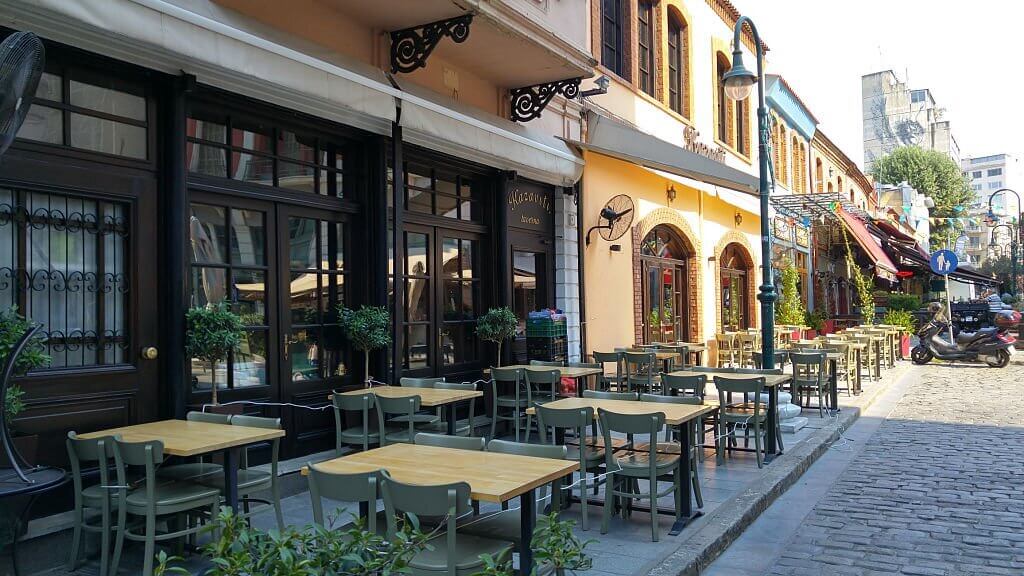
But it all came to an end in 1917 when a wildfire burnt the majority of Thessaloniki and all of Ladadika. After that, the city was restored and rebuilt from scratch, this time with more advanced and modern architecture. But, it was neglected, and people began to forget about Ladadika, until the 20th century, when a new interest in historic places began to grow, and people learned about Ladadika and its great preserves of history. In the 1990s, Ladadika was again transformed, only this time a majority of buildings were reconstructed to their old form. Many old warehouses were transformed into attractive shops, restaurants, and bars. Making Ladadika a source of modern entertainment and fun nightlife. Today, Ladadika is one of the most visited places in all of Thessaloniki. You will find a number of attractions here such as traditional taverns, boutique shops, art galleries, bars, and more. One of the best things about Ladadika is that it has mastered the art of preserving its history and balancing it with modern times.
9. Church of Agia Sofia
Being one of the oldest churches of Thessaloniki, the Church of Agia Sofia was built in the 3rd century A.D. in Egnatia, but it was destroyed. It was then reconstructed in the 8th century and has been kept as it is since then. It was in 1205 A.D when Thessaloniki was captured by the Fourth Crusade, Agia Sofia was turned into a church, and then in 1430 A.D when the Ottomans took over Thessaloniki, they converted the church into a mosque, and it stayed a mosque until 1912. Then in 1917, it was turned back into a church, but it was then greatly damaged by the wildfire, the interior was completely destroyed, and then in 1978, an earthquake destroyed the majority of the church.
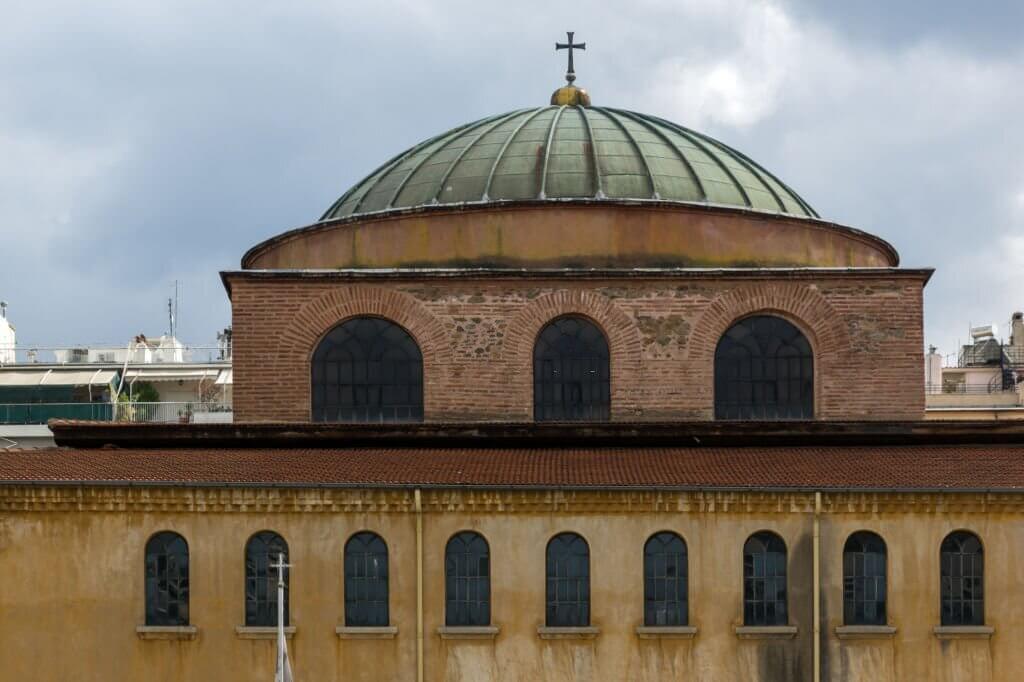
Today, the church might not be as famous as its namesake in Istanbul, but its magnificent beauty helps it attract a number of tourists from all over the world. The old brickwork and the gold color mélange make the Church of Agia Sofia a stunning sight, which cannot be matched. The church is open for visitors from 8:30 am to 8:00 pm, and there is no entrance fee or time slot, so you can visit whenever you want and for however long you want.
10. Agios Dimitrios Church
Agios Dimitrios Church is a historical and religious landmark in Egnatia, Thessaloniki. Also known as the Church of Saint Demetrius is dedicated to Saint Demetrius, who was known as the patron saint of Thessaloniki. The church was first built in the 4th century after Saint Demetrius died in a war. According to some of the historic teachings, it is believed that the original church was built where Saint Demetrius died in 303 A.D. The Church has gone through a number of expansions and reconstructions because of many things like earthquakes, invasions, wildfires, and more. The current face of Agios Dimitrios Church was achieved after multiple construction phases.
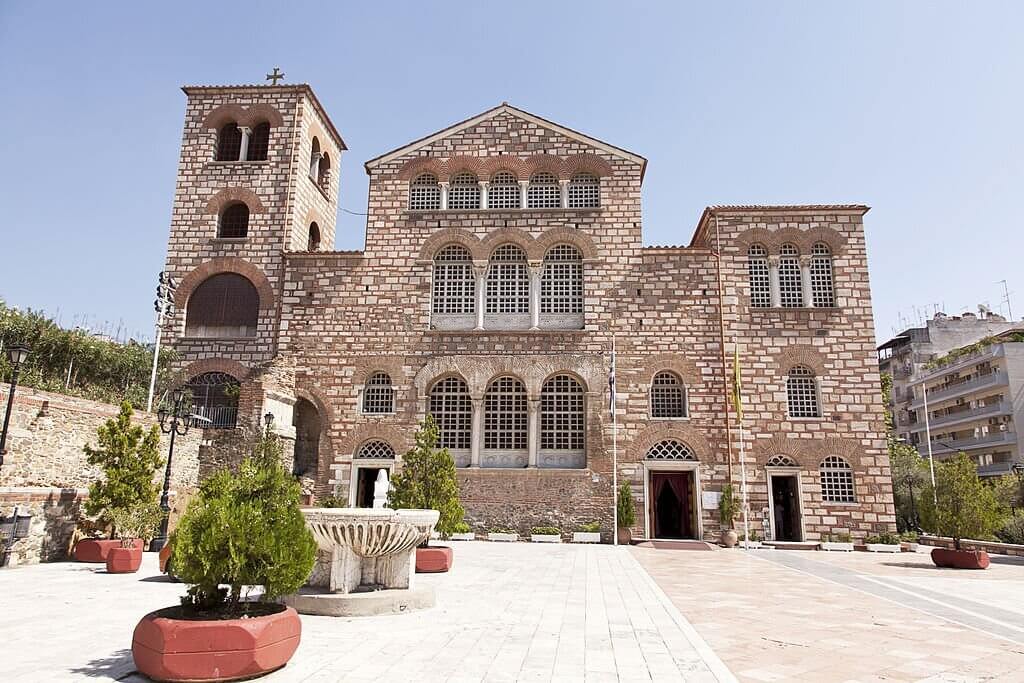
Over the period of time, the church has been used for multiple purposes; at first it was used as a church, then it was turned into a mosque, and then was restored as a church. Today, the Church of Saint Demetrius stands as an example to represent the great architecture of the Byzantine era. It has marble decoration, attractive frescoes, elaborate mosaics, and a beautiful interior that reflects the life of the great Saint Demetrius. There is also a crypt in the church where it is believed that the remains of Saint Demetrius were actually buried. Agios Dimitrios holds great historic and cultural value in Thessaloniki. The site attracts visitors from different areas of the world, who visit to experience the great church and admire its beauty. The church is open to the public from 10:00 am to 8:00 pm, and there is no entrance fee to enter.
11. Roman Market
The Roman Market of Thessaloniki used to be the center of all major activities in the city from the 3rd century B.C. to the 5th century A.D. Located in the middle of Olympou Street and Filippou, this market used to represent the religious and social side of Thessaloniki. The market was known to be the most modernized area of the city back in its days. The whole market was built in a rectangular square shape, with two lofts of three sides. But the buildings and the whole complex were destroyed during the Byzantine period due to the massive earthquake and invasions.
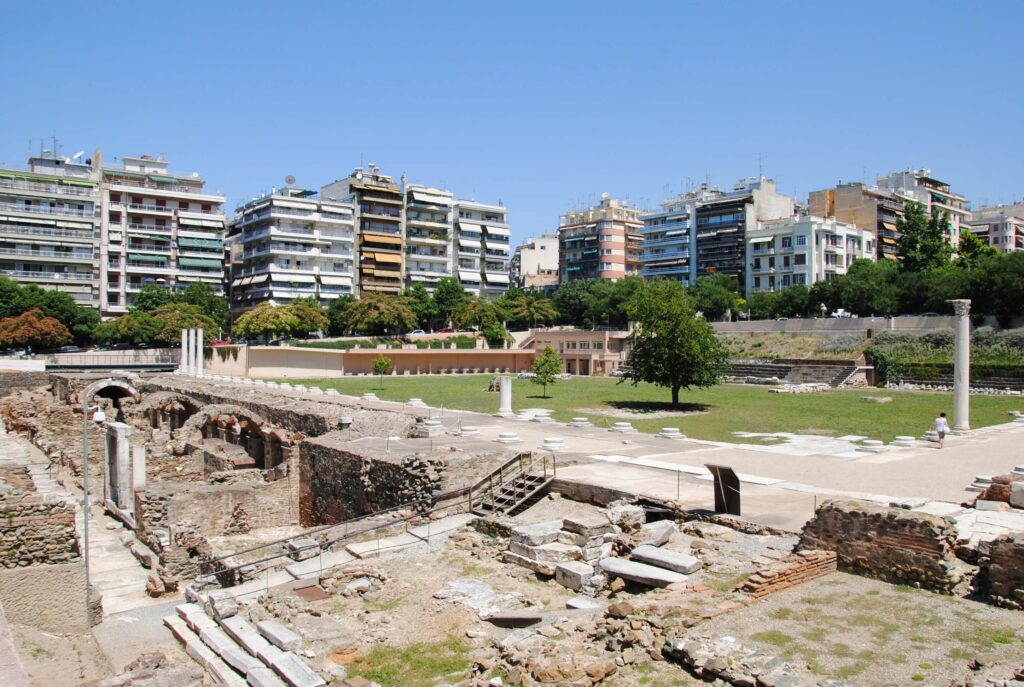
During its excavation, many things were discovered like the public buildings, the conservatories, the mint, a warehouse, and more. Today, the Roman Market is more of an archeological site, where people visit to attend different concerts and cultural and religious events during peak tourist season.
12. Church of Agios Nikolas Orfanos
Located in the middle of Apostle Paul streets and Herodotus, the Church of Agios Nikolaos Orfanos. It was built in 1310, with a pretty simple structure, and amazing decoration to add up to its beauty. The craftsmanship on the walls of the church holds a separate spot in being the most beautiful preserve in Thessaloniki. Some people also say that a Serbian monk painted these boundaries when the church was built because they tell a story from Agios Nikolaos and other saints’ lives. Archeologists also believe that the church used to be a tomb in the past, as they discovered some graves during the restoration process. Every corner that was discovered in this church by the archeologists tells that it was built in early ages, and was one of the greatest constructions of its time. The church also says that Agios Nikolaos was also believed to be a huge supporter of widows and orphans, which justifies his title Orfanos. Some also believe that the church used to have an orphanage in one of its courtyards, which explains the title Orfanos. The Church of Agios Nikolaos has survived a lot, it was never converted into anything else than a church, even during the Turk era, the church was left as a church. So, if you wish to visit this beautiful historical monument, we would suggest that you do so anywhere between 10:00 am to 1:00 pm, and you do not have to worry about paying an entrance fee because it is free.
13. Bey Hamam
Built on Egnatia Street, the Ottoman bathhouse dates back to the 15th century. Bey Hamam is an open bathhouse, which was inspired by Turkish culture, and it was the first and the biggest hamam in all of Greece, which gives it great historic importance. The Hamam was built by Murad II, in 1444, and it has two separate rooms for men and women. The area for men is more spacious and luxurious as back in the day, emperors used to bring their guests to this Hamam to show them the versatile culture they promote in Thessaloniki. It was also called the “Baths of Paradise” and it operated till 1968 under that name. But, Hamam was heavily damaged in 1978 by an earthquake. However, it was restored, and today the Hamam is used for multiple purposes like hosting events, exhibitions, and of course holding bathing sessions.
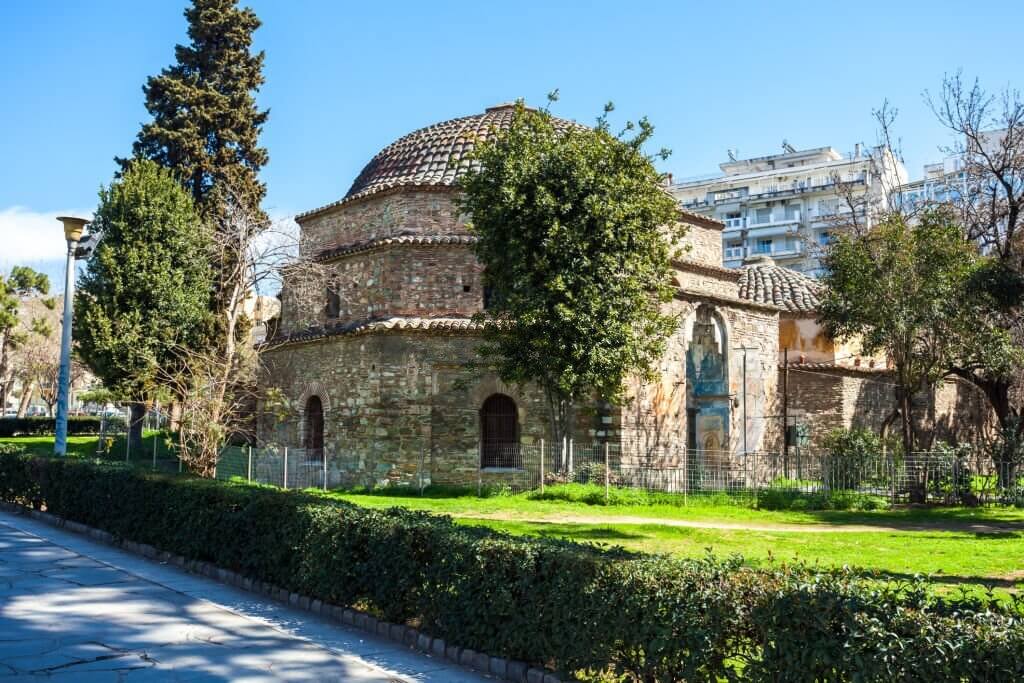
14. Church of Panagia Halkeon
The Church of Panagia Halkeon was built back in 1028 by the governor of Lomvardi Christophoros, right above an old pagan church. Located in the Ancient Agora Square, in Aristotle Square, the church even houses the graves of its founder on the northern side. The name of the church translates to “Virgin Mary of the Cooper Workers” because the quarter half of the church was next to the cooper worker’s neighborhood.
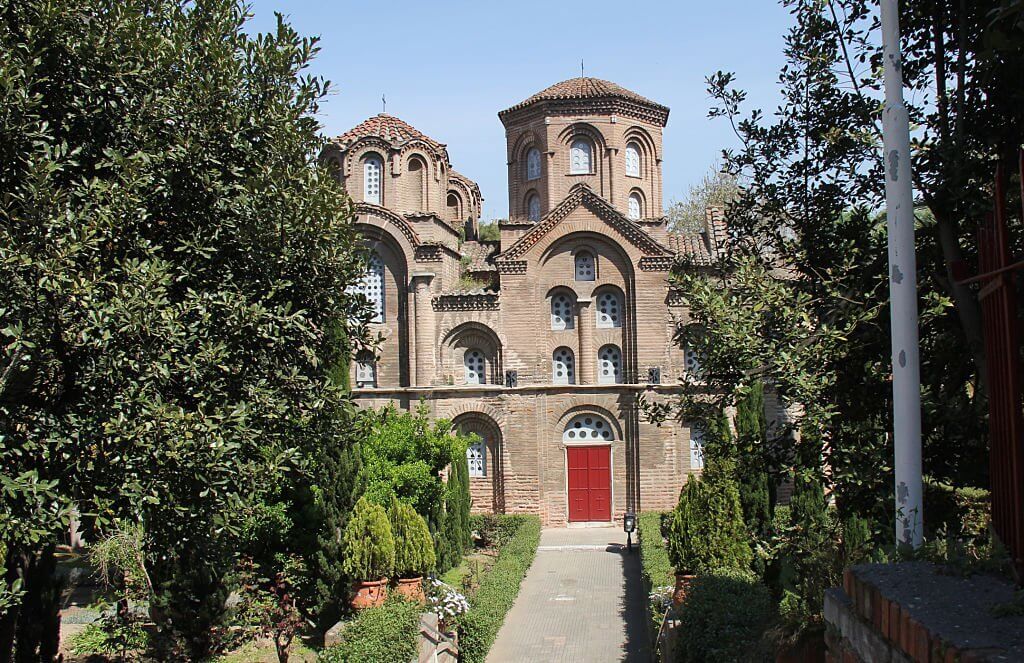
The church is built in a typical Byzantine style, with columns and domes. The walls and boundaries of the church are extremely interesting and the craftsmanship tells that it was done back in the 11th and 14th centuries. The exterior, however, is completely made of bricks, which was why many people used to call it the Red Church as well. Just like many other churches, this was also converted into a mosque when the Ottomans conquered Thessaloniki but was converted back to a church in 1912, once Thessaloniki was freed. The church faced major damage during an earthquake in 1932 and was restored within the same year. The church opens for the public and visitors at 7:30 am and closes at 12:00 pm every day.
15. Park of Dinosaurs
Last on our list is the Dinosaur Park of Thessaloniki. The large ecological site of Thessaloniki is built near the suburbs of Oreokastro and Galini. The park was opened back in 2008 and is said to be the largest dinosaur park in all of Europe with a total area of 10,000 m2. It is said to include real-life-size monuments of all the known dinosaur species, a mammoth museum, prehistoric caves to show the evolution of humans, a sea-life museum, a reptile museum, a botanical museum with herbs and plants, and an interesting gift shop from where you can buy souvenirs for your friends and family. The park is open only on Saturday and Sunday from 11:00 am to 3:00 pm, and the entrance fee is €10 for adults and €8 for kids. So, if you wish to visit this amazing place then we would suggest that you book your tickets in advance.
What is the nightlife like in Thessaloniki?
Thessaloniki offers a vibrant and lively nightlife scene. The city is known for its diverse range of bars, clubs, and entertainment venues that cater to various preferences and tastes. Whether you’re looking for a relaxing evening at a cozy bar or a night filled with music and dancing at a bustling club, Thessaloniki has something for everyone. The nightlife in Thessaloniki is particularly popular among the city’s young population, thanks to its numerous universities and colleges. You can expect a dynamic atmosphere, live music performances, DJ sets, and a wide selection of drinks and cocktails to enjoy throughout the night. The best bars in Thessaloniki are Kafodeio Elliniko, Dentro Sto Bar, and Avgoustos. Kafodeio Elliniko is a family-owned and operated bar that has been serving Thessaloniki for over 50 years. The bar is known for its traditional Greek drinks, such as ouzo and raki, as well as its delicious food, such as souvlaki and moussaka. While Dentro Sto Bar is a trendy bar that is popular with locals and tourists alike. The bar has a lively atmosphere and offers a variety of drinks, including cocktails, beer, and wine. The bar also has a small food menu that features tapas-style dishes. These bars are all located in the city center and are easily accessible by public transportation.
What is Thessaloniki best known for?
Thessaloniki, a city in Greece, is known for its rich history, beautiful architecture, vibrant culture, delicious food, lively festivals, prestigious universities, and vibrant nightlife. The city’s main attractions include the White Tower, offering panoramic views, and the Rotunda, an ancient Roman structure with a diverse past. Visitors can indulge in local cuisine, desserts, and beverages at the city’s markets and cafes. Thessaloniki hosts various festivals, with the Thessaloniki International Film Festival being particularly renowned. The presence of top universities gives the city a youthful and enjoyable atmosphere. The nightlife scene in Thessaloniki is famous, offering opportunities to listen to music, dance, and socialize at numerous bars and clubs. Overlooking the city and the sea, the Byzantine walls serve as a reminder of Thessaloniki’s extensive historical background.
What are the free things to do in Thessaloniki?
Exploring the charming streets of Ano Poli, the city’s old town, offers a glimpse into its traditional architecture and stunning views of the city and Thermaic Gulf. Strolling through Aristotelous Square provides a lively atmosphere, opportunities for people-watching, and breathtaking views of the seafront. Thessaloniki’s beautiful parks, including the Seikh Sou Forest National Park and Mediterranean Garden, offer lush green spaces for a relaxing stroll in nature.
Where to eat in Thessaloniki?
Thessaloniki has a vast variety of food options. Whether you are a fan of street food or you want to have a fine dining experience, Thessaloniki has it all. The top restaurants in Thessaloniki are Maiami Seafood Restaurant, Vregmeni Gata Restaurant, and The Backroom. The Maiami Seafood Restaurant, located in Kalamaria, has a rich heritage spanning four generations. With a seaside patio and stylish indoor lounges blending vintage and modern elements, the restaurant is a 22-minute car ride from Thessaloniki. In the city center, Vregmeni Gata Restaurant is a cozy Greek café renowned for its mix of modern and traditional cuisine, including fine meats, seafood, meze dishes, and fresh salads. And just 15 minutes away from the Church of St. Demetrios, The Backroom SKG specializes in Italian and Argentinian fare. Guests can enjoy breakfast items, grilled meats, steaks, seafood, homemade pastas, salads, and desserts, complemented by an extensive selection of local and international wines. To explore more of top restaurants in Thessaloniki, our blog on top restaurants in Thessaloniki will help you pick. All you have to do is book a cab and get to the restaurant.
How to get around Thessaloniki?
Thessaloniki provides a range of transportation options to get around Thessaloniki that suit different needs. Public buses offer convenience and affordability, taxis offer quick and metered rides, and car rental services provide flexibility for independent exploration. For those seeking flexibility and independence, car rental services are widely available in Thessaloniki. Renting a car allows you to explore the city and its surrounding areas at your own pace, offering convenience and the ability to visit remote locations. Various car rental companies operate in the city, offering a diverse range of vehicles to cater to individual preferences.
Potos Car Rental are known for providing the best Thessaloniki car rental service. With a friendly staff, a great collection of cars, and a reasonable package, they have been acing in the car rental business. They have the most reliable drivers in all of Thessaloniki. Also, they provide you with the best and most luxurious cars so you travel comfortably with style.
What are the things to consider while renting a car in Thessaloniki?
Here is a list of things you must consider while renting a car in Thessaloniki:
- Insurance. It is necessary that you have a working debit or credit card and Collision Damage Waiver insurance while renting a car to guarantee that the owner will get it back in the same condition. If you do not have either of them, then you have to pay extra money to guarantee safety. Also, any insurance does not cover the glass and mirror destruction, so if it happens, we would suggest that you call for help and stay there.
- Drivers Age. The driver must be over 21 years old and have a valid driver’s license to drive the car. There are some companies as well whose age limit starts from 23 years.
Driver’s Gender. Thessaloniki does not discriminate between a man and a woman. Both men and women can drive or rent a car in Thessaloniki. - Car Type. You must look at how many people and luggage you have before renting a car. You can inform the rental service provider about it, and then they will send the car which will be suitable for all of you.
- Required Documents. The rental car provider will need your credit card details and driver’s license under the name of the driver to avoid any unnecessary disaster. If the first driver does not have a valid driving license, the second driver’s license must be needed.
How much does a car rental cost in Thessaloniki?
On average, renting a standard car for a week in Thessaloniki would cost around €280. However, it’s important to note that prices can range from €154 to €595 per week, depending on factors such as the size of the car, additional features (like automatic or manual transmission), and the number of people it can accommodate. Thessaloniki Airport serves as the main pick-up and drop-off location for car rentals in the area. Most rental packages include unlimited mileage, allowing customers the freedom to explore the region without additional charges. It’s worth mentioning that rented cars typically need to be returned with the same amount of fuel to avoid extra fees.

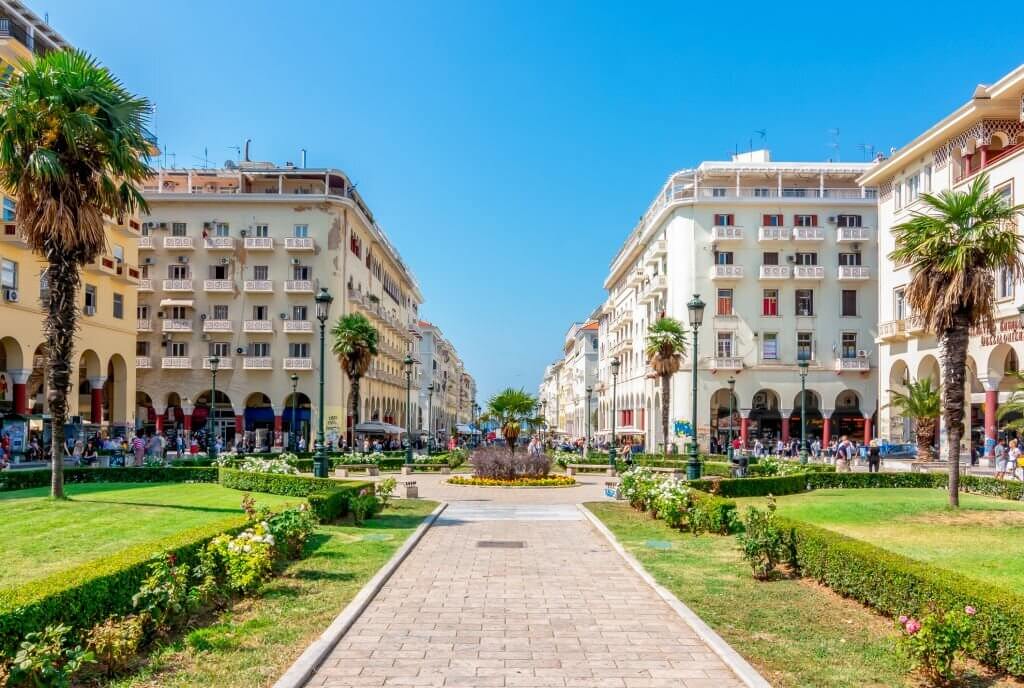
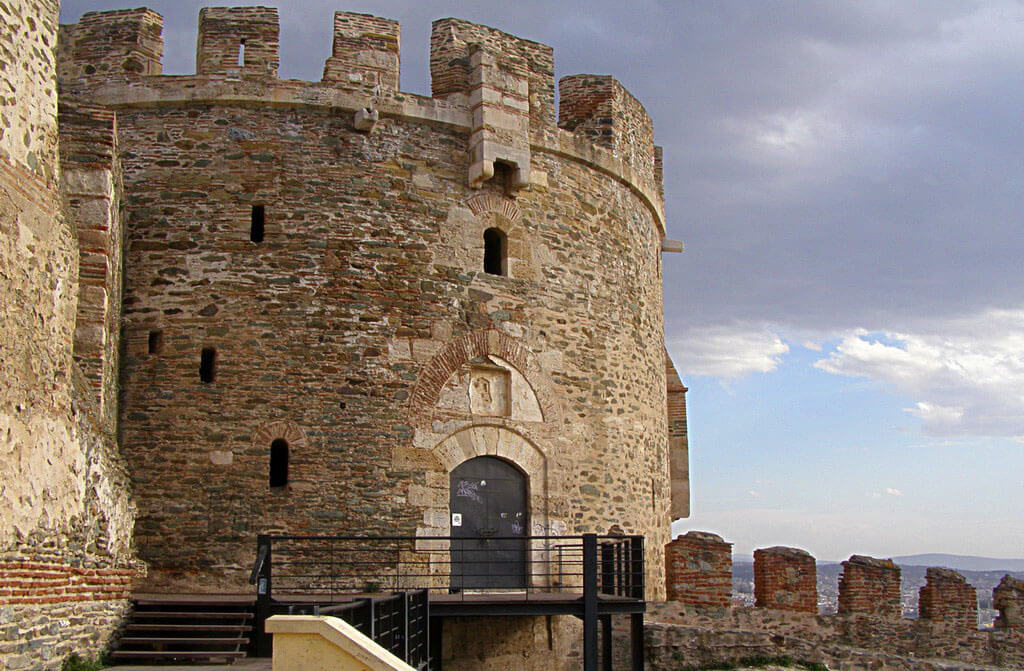
 German
German Greek
Greek Română
Română Polski
Polski


